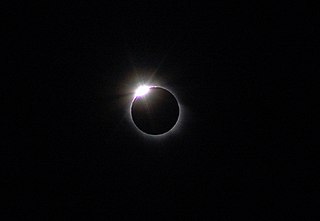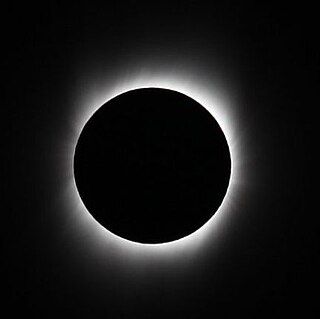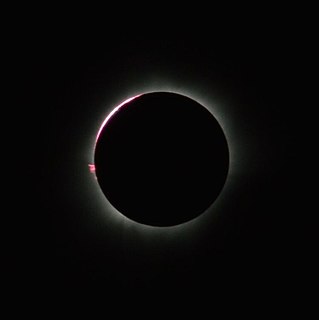
A total solar eclipse occurred on March 29, 2006. A solar eclipse occurs when the Moon passes between Earth and the Sun, thereby totally or partly obscuring the image of the Sun for a viewer on Earth. A total solar eclipse occurs when the Moon's apparent diameter is larger than the Sun's, blocking all direct sunlight, turning day into darkness. Totality occurs in a narrow path across Earth's surface, with the partial solar eclipse visible over a surrounding region thousands of kilometres wide. It was visible from a narrow corridor which traversed half the Earth. The magnitude, that is, the ratio between the apparent sizes of the Moon and that of the Sun, was 1.052, and it was part of Saros 139.

A total solar eclipse occurred at the Moon's descending node of the orbit on July 22, 2009, with a magnitude of 1.07991. It was the longest total solar eclipse during the 21st century; the longest total solar eclipse during the 3rd millennium will be on 16 July 2186. It lasted a maximum of 6 minutes and 38.86 seconds off the coast of Southeast Asia, causing tourist interest in eastern China, Pakistan, Japan, India, Nepal and Bangladesh. Its greatest magnitude was 1.07991, occurring only 6 hours, 18 minutes after perigee, with greatest eclipse totality lasting 6 minutes, 38.86 seconds during the Total Solar Eclipse of July 22, 2009.

A total lunar eclipse took place on 3 March 2007, the first of two eclipses in 2007. The moon entered the penumbral shadow at 20:18 UTC, and the umbral shadow at 21:30 UTC. The total phase lasted between 22:44 UTC and 23:58 UTC with a distinctive brick-red shade. The moon left the umbra shadow at 01:11 UTC and left the penumbra shadow at 02:24 UTC 2007-03-04. The second lunar eclipse of 2007 occurred on 28 August.

A total lunar eclipse occurred on February 20 and February 21, 2008. It was visible in the eastern evening sky on February 20 for all of North and South America, and on February 21 in the predawn western sky from most of Africa and Europe. Greatest Eclipse occurring on Thursday, February 21, 2008, at 03:26:03 UTC, totality lasting 49 minutes and 45.6 seconds.

A partial lunar eclipse took place on 16 August 2008, the second of two lunar eclipses in 2008, with the first being a total eclipse on 20 February 2008. The next lunar eclipse was a penumbral eclipse occurring on 9 February 2009, while the next total lunar eclipse occurred on 21 December 2010.

A total lunar eclipse took place on 15 June 2011. It was the first of two such eclipses in 2011. The second occurred on 10 December 2011. While the visual effect of a total eclipse is variable, the Moon may have been stained a deep orange or red colour at maximum eclipse.

A penumbral lunar eclipse took place on 7 July 2009, the second of four lunar eclipses in 2009. This eclipse entered only the southernmost tip of the penumbral shadow and thus was predicted to be very difficult to observe visually. This lunar eclipse was the predecessor of the solar eclipse of 22 July 2009.

A partial lunar eclipse was visible on 31 December 2009. It was the last and largest of four minor lunar eclipses in 2009. This lunar eclipse was also notable, because it occurred during a blue moon and was near perigee. The next eclipse on New Year's Eve and blue moon will occur on 31 December 2028.

A partial lunar eclipse took place on 4 June 2012. It was the first of two lunar eclipses occurring in 2012, the second eclipse set to happen on 28 November. The moon was about 37% covered by the Earth's northern umbral shadow at maximum eclipse.

A partial lunar eclipse took place on 25 April 2013, the first of three lunar eclipses in 2013. Only a tiny sliver (1.48%) of the Moon was covered by the Earth's umbral shadow at maximum eclipse, but the entire northern half of the Moon was darkened from being inside the penumbral shadow. This was one of the shortest partial eclipses of the Moon for the 21st century, lasting 27 minutes. This was the last of 58 umbral lunar eclipses of Lunar Saros 112.

A total lunar eclipse took place on 15 April 2014. It was the first of two total lunar eclipses in 2014, and the first in a tetrad. Subsequent eclipses in the tetrad are those of 8 October 2014, 4 April 2015, and 28 September 2015. Occurring 6.7 days after apogee, the Moon's apparent diameter was smaller.

A total lunar eclipse took place on Wednesday 8 October 2014. It is the second of two total lunar eclipses in 2014, and the second in a tetrad. Other eclipses in the tetrad are those of 15 April 2014, 4 April 2015, and 28 September 2015. Occurring only 2.1 days after perigee, the Moon's apparent diameter was larger, 1960.6 arcseconds.
A penumbral lunar eclipse took place on 23 March 2016, the first of three lunar eclipses in 2016. The Moon was just 2.1 days before apogee, making it very small, so this was a "Micromoon" penumbral lunar eclipse.

A partial lunar eclipse took place at the Moon's descending node on the evening of 7 August and the morning pre-dawn on 8 August 2017, the second of two lunar eclipses in 2017. The Moon was only slightly covered by the Earth's umbral shadow at maximum eclipse. The Moon's apparent diameter was smaller because the eclipse occurred only 5 days after apogee.

A total lunar eclipse occurred on Tuesday, 8 November 2022. The southern limb of the Moon passed through the center of the Earth's shadow. It surpassed the previous eclipse as the longest total lunar eclipse visible from nearly all of North America since 17 August 1989, and until 26 June 2029. Occurring only 5.8 days before apogee, the Moon's apparent diameter was smaller. The next total lunar eclipse will take place on 14 March 2025. A lunar occultation of Uranus happened during the eclipse. It was the first total lunar eclipse on Election Day in US history. This event was referred in media coverage as a "beaver blood moon".
A penumbral lunar eclipse took place on Thursday, March 3, 1988, the first of two lunar eclipses in 1988, the second being on August 27, 1988. Earlier sources compute this as a 0.3% partial eclipse lasting under 14 minutes, and newest calculations list it as a penumbral eclipse that never enters the umbral shadow. In a rare total penumbral eclipse, the entire Moon was partially shaded by the Earth, and the shading across the Moon should have been quite visible at maximum eclipse. The penumbral phase lasted for 4 hours, 53 minutes and 50.6 seconds in all, though for most of it, the eclipse was extremely difficult or impossible to see. The Moon was 2.2 days after apogee, making it 6.1% smaller than average.

A total lunar eclipse occurred on 31 January 2018. The Moon was near its perigee on 30 January and as such may be described as a "supermoon", when the Moon's distance from the Earth is less than 360,000 km. The previous supermoon lunar eclipse was in September 2015.

A partial lunar eclipse occurred on 19 November 2021. The eclipse occurred towards a micromoon. This was the longest partial lunar eclipse since 18 February 1440, and the longest until 8 February, 2669; however, many eclipses, including the November 2022 lunar eclipse, have a longer period of umbral contact at next to 3 hours 40 minutes. It was often referred to as a "Beaver Blood Moon" although not technically fulfilling the criteria for a true blood moon (totality).

A total solar eclipse took place at the Moon's descending node of the orbit on March 8–9, 2016. If viewed from east of the International Date Line, the eclipse took place on March 8 (Tuesday) and elsewhere on March 9 (Wednesday). A total solar eclipse occurs when the Moon's apparent diameter is larger than the Sun's and the apparent path of the Sun and Moon intersect, blocking all direct sunlight and turning daylight into darkness; the sun appears to be black with a halo around it. Totality occurs in a narrow path across Earth's surface, with the partial solar eclipse visible over a surrounding region thousands of kilometres wide. The eclipse of March 8–9, 2016 had a magnitude of 1.0450 visible across an area of Pacific Ocean, which started in the Indian Ocean, and ended in the northern Pacific Ocean.

An annular solar eclipse occurred on Sunday, June 21, 2020. An annular solar eclipse is a solar eclipse whose presentation looks like a ring, or annulus; it occurs when the Moon's apparent diameter is smaller than the sun's, blocking most, but not all, of the sun's light. In this instance, the moon's apparent diameter was 0.6% smaller than the sun's.






































































